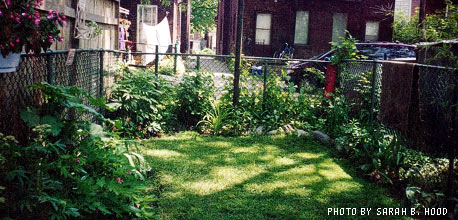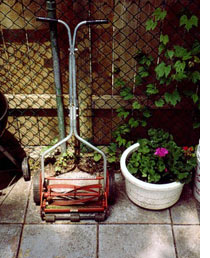
Guest post by Sarah B. Hood
When we moved into our narrow city house with its postage-stamp backyard, my partner Jonathan outed himself as a lawnie: a leaning more frequently found among men than women, I’ve found. My dad was never happier than when spraying an arc of water over his little plot of grass; similarly, Jonathan likes to sit on the picnic table with a paperback in one hand and a hose in the other.
Jonathan grew up in a semi-developed suburb, where residential yards blended seamlessly with woodsy areas. For him, a lawn is where kids play hide-and-seek, and where grownups chill in a lawn chair with an iced tea, a radio and a book. He was surprised to learn that the North American lawn is the subject of controversy.
Of course, some see lawns as artificial environments that are inhospitable to many creatures and too often maintained with an arsenal of chemical agents. Nonetheless, Jonathan and I have found, a little bit of grass is nice to walk on, pretty to look at and easy to maintain in a more natural way. Here’s how:
Water infrequently but deeply
- Instead of watering on a schedule, wait for the soil to dry out. When the grass seems to curl a little, water a lot (but not at midday, when it’ll just evaporate).
- If you have time, water for a while, then wait, then do it again. (This helps water penetrate deeper into the soil.) If it rains a little, water a bit more afterwards.
- During heat and drought, grass goes dormant. It needs less water then; just enough to keep it from turning completely yellow.
Mow high

- Taller grass has more chance to fight off weeds, so don’t cut it shorter than three inches.
- Try not to cut more than a third of the height off at once.
- Keep your mower blade sharp, so it will damage the grass less.
- Don’t rake up your clippings, unless you’ve cut back a lot. (Yes, it looks neater if you rake, but your lawn will be greener if you give it back that good nitrogen.)
- Luckily, grass grows most in spring when you’re eager to be in the garden. It’ll slow down by July.
Feed regularly
- Top-dress your lawn by sprinkling it with organic fertilizer, extra topsoil, compost and/or manure. The worms will do the work of getting it into the soil. (But fallen leaves smother grass, so rake them off, especially in early spring.)
- Cool-climate grasses need to be fertilized in early spring and fall, when they have growth spurts.
- Warm-climate grasses want two spring doses and none in fall.
- White clover naturally fixes nitrogen in the soil. If you have a big lawn and you don’t mind some nice hardy ground cover in with the grass, consider seeding it with clover.
Weed by hand if possible
- If you have a small space, you can get rid of most weeds by hand. Dandelion forks are cheap, and help you get most of the roots out.
- If you have a very big yard, consider just mowing down the weeds instead of removing them. After all, they’re extremely drought-resistant.
- The best way to fight weeds and destructive insects is by nurturing healthy grass so it’ll compete on its own.
Aerate
- Your grass wants to grow in light, airy soil. (Worms like this too.) In spring, jab a pitchfork into the ground and wiggle it, making as many holes as you like. (For big lawns, there are specialized tools for this that are more efficient.)
- Avoid walking on the lawn when the ground is squishy and muddy in early spring.
Bring in reinforcements
- You can sprinkle extra grass seed when you fertilize; it’s cheap and easy. Water it often and don’t worry if the birds eat some. It’s exciting to see the new sprouts!
- There are many types of grass, with great names like fescue. Some are good for shade, some for heat, and so on; you can buy mixtures. Consult with your local garden store to see what works in your zone.
- If you have a bald patch, you can lay down a roll of sod. It’s much more expensive than seed, but it looks good right away. It should be laid on a bed of nicely turned, rich topsoil. Stamp it down well to seat the roots, and water it often until it starts to grow.
And also…
Don’t even try to grow grass right under a tree or in a heavy-traffic area. These situations call for a few well-placed paving stones, a wood-chip path or some shade-tolerant ground cover.
If your lawn looks sad, get your PH tested (that’s the acid/alkaline balance of your soil). The quick-and-dirty method: dandelions thrive in alkaline soil, which you can correct with gardener’s sulphur. Moss loves acid, which can be balanced with pelletized lime. (We’ve never done this, but we thought you’d like to know.)
Don’t make yourself crazy when you mow. Instead of chopping off the ends of your hostas, make a mulch border or dig a trench between the flowerbeds and the grass. Fill in hard-to-mow corners with something forgiving like a clump of ornamental grass.
If you get snow in your area, make sure you and your neighbours aren’t throwing salt on your grass. (Where does sidewalk runoff go?)
Finally, don’t spend more time fussing with the lawn than you do enjoying it. Make your first lawn investment a cheap and comfy lawn chair, a paperback and some iced tea. They’re bound to make your grass look great.